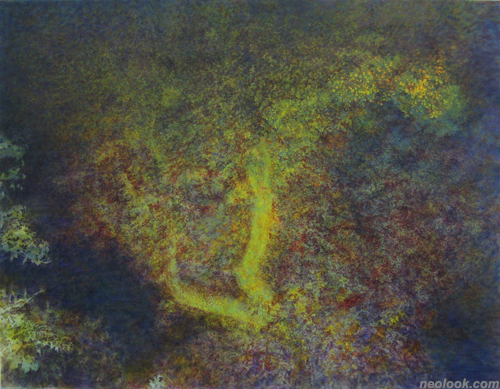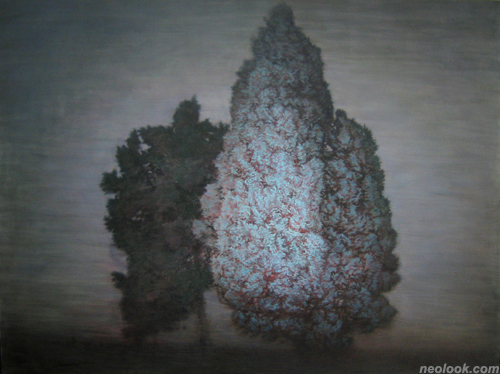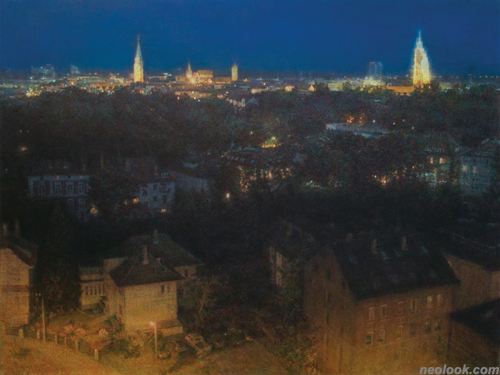- ● homepage
- ● archives
- ● restoration
- ● books
- ● big banners
- ● post board
- ■ neo's search
- ■ about us
- ■ 게재방법 안내
- 개인정보처리방침

- [email protected]
- Tel. 02_335_7922
- Fax. 02_335_7929
- 10:00am~04:30pm
- 월요일~금요일
- 3/3(월) 대체공휴일

깊이 있는 표면 The Surface with Depth
이만나展 / LEEMANNA / 李만나 / painting 2010_0422 ▶ 2010_0509 / 월요일 휴관
● 위 이미지를 클릭하면 네오룩 아카이브 Vol.20040625b | 이만나展으로 갑니다.
초대일시_2010_0422_목요일_06:00pm
관람시간 / 11:00am~06:00pm / 월요일 휴관
브레인 팩토리_BRAIN FACTORY 서울 종로구 통의동 1-6번지 Tel. +82.2.725.9520 www.brainfactory.org
깊이 있는 표면 ● 이만나의 그림은 어둡고 흐릿하며 깊다. 가물가물한 그림의 피부에는 물감의 얼룩과 흔적들이 뿌옇게 성에꽃처럼 피었다. 그 꽃들이 순간 풍경이 되고 나무가 된다. 그는 도시의 야경과 나무, 담쟁이 등을 그렸다. 자신의 일상의 동선에서 늘상 보던 것들이다. 매번 보아서 익숙하고 잘 알 것 같은 대상들이지만 볼수록 그것들은 낯설고 기이하다. 특히 초월적이고 신비스러움을 고양시키는 밤은 그 낯설음을 증폭시킨다. 그는 부분적으로 빛의 편애를 받는 건물과 정원, 나무를 섬세하게 주목했다. 그가 본 자연은 인간의 관리와 통제 속에서 심미적으로 혹은 기능적으로 축소되고 왜곡된 상태로 길들여진 이른바 '가축화된 자연'이다. 사람들은 여러 목적에 의해 풀과 나무를 잘라내고 가꾸고 보듬는다. 인간의 욕망에 의해 가꾸어지고 관리된 것들이다. 그럼에도 자연은 스스로를 치유하고 넘어서면서 경계를 지워 나가려 한다. 가둘 수 없고 관리될 수 없는 자연이다. 그래서 숲, 풀이 지닌 생명력은 무섭기도 하다. 밤은 그 야생의 자연이 지닌 신비스러운 힘들을 풀어 놓는다.

- 이만나_날개_캔버스에 유채_155×200cm_2008
자신의 일상에서 매번 접하는 이 '아무것도 아닌' 풍경들이 어느 날 낯설고 기이하게 다가왔던 것이다. 그는 그런 의문, 이해하기 힘든 그러나 분명 내 내부에서 감지하는, 더구나 욕망하는 힘에 의해 그 대상을 다시 주의 깊게 들여다보고 오랫동안 그렸다. 그림을 그려나가는 시간 동안 그는 알 수 없는 의문과 지속적으로 대면한다. 결국 그가 그린 것은 특정 대상의 외양이 아니라 그로부터 촉발된 자기 내부의 컴컴한 초상이다. 세계는 주체에게는 늘 수수께끼다. 그러니까 카뮈 식으로 말하면 부조리하다. 그것은 우리가 배운 언어와 문자의 틀들을 유유히 빠져나간다. 지식은 날 것의 세계, 대상 앞에 한없이 무력하다. 외계는 내 내부로 들어와 매순간 암전된다. 결국 재현은 불가능하고 자꾸 미끄러진다.

- 이만나_더 이상 거기에 없는 풍경_캔버스에 유채_150×200cm_2008
이만나의 그림은 분명 특정 대상의 재현이고 가시적 세계를 보여주는 것 같지만 실은 그 이면을, 세계의 내부를, 자신의 속을 뒤집어 보여준다. 그는 자신을 둘러싼 외부세계를 관습이 아닌 그것 자체로 생생하게 접촉할 때 생기는 생소함을 그리고자 한다. 그러니까 의미가 소멸된 사물 자체를 바라보게 되는 순간, 순전히 보고 있는 그 자체를 그리는 것이다. 기능과 의미가 지워진 자리에는 기묘하고 낯선 이미지만 남게 된다. 이런 생경한 이미지로부터 사물은 비로소 의미의 대상이 아닌 '의미의 주체'가 된다. 알려진 모든 선입견과 편견이 지워진 지점에서의 사물과의 우연한 만남, 맞닥뜨림, 그리고 이로부터 또 다른 가능한 세계와 대면하는 것이 그의 그림이다. 그것은 분명 여기, 이곳의 풍경이지만 동시에 이곳에 없는 풍경이기도 하다. 일상과 비일상 사이에 있는 묘한 풍경이다. 있으면서 부재한, '없지 않은' 그런 풍경이다. 따라서 그것은 현실과 비현실, 시각과 비시각, 객관성과 주관성 사이에 위치한 모호한 풍경이 되었다. 모든 대상은 표면, 피부만을 보여주지만 작가는 그 이면을 생각해본다. 분명 껍질은 본질은 아니지만 그 이면을 상상하게 해주는 불가피한 표면이다. 표면을 통해 무한한 공간을 연상해보고 들어가 본다. 그림이란 것 역시 부득이 사물의 외피를 주어진 캔버스의 표면 위로 밀착시키는 일이지만 동시에 보이지 않는 내부를, 어떤 이면을 암시하는 일이다. 그것은 너무 깊은 표면이 된다.

- 이만나_깊이 없는 풍경_캔버스에 유채_90×150cm_2006
그는 바로 지금 내 앞에 있다는 그 현재라는 시제에 만난 것, 어떤 것이 이 순간 바로 내 앞에 있는 현전의 체험에서 문득 낯선 느낌을 받는다. 그는 익숙하고 일상적인 것들이 어느 순간 낯설게 다가옴을 느낀 것이다. 그리고 그것들은 강한 힘을 발산한다. 낯설음이란 특정한 외부의 경험에 의해 생성된 내적인 심리상태를 지칭한다. 그는 자신이 보고 있는 지금의 풍경, 대상을 의심한다. 내가 보고 있고 알고 있는 것만이 전부는 아닐 것이다. 눈에 보이는 것만이 세계는 아니다. 특정 풍경을 보고 있노라면 온갖 형상들도 상상되고 이질적인 것들이 겹쳐 보인다. 시간이 정지되어 버린 신화 속 풍경 같다. 그는 인간이 감지하는 이 세계 외에 어떤 것을 본다. 보고자 한다. 일상의 시간 속에서 느닷없이, 불현듯 나타나는 것들을 만난다. 현실세계에 비이성적이고 신화적인 세계가 순간 침입한 것이다. 순간 현실은 금이 가고 '이격 離隔'된다. 작가는 그런 풍경을 '헤테로토피아'로 설명한다.

- 이만나_무대_캔버스에 유채_각 30×40cm_2006

- 이만나_모퉁이_캔버스에 유채_각 30×40cm_2008
그는 일상의 장면을 사진으로 찍고 이를 참조해서 그림을 그렸다. 목탄으로 드로잉을 한 후 물감을 뿌리고 흘리고 덮어나가면서 어떤 장면을 재현한다. 아니 비재현적으로 재현한다. 스스로 재현하는 것 말고 우연적 효과, 의도하지 않는 상태로 해결하고 싶기에 물감을 뿌리고 흘리고 칠해나가면서 그려나간다. 따라서 물감의 입자, 얼룩, 방울들이 모여서, 집적해서 두툼한 풍경의 깊이를 얇게 만든다. 그 위로 스며들고 얹혀 지는 붓질은 자신이 대상으로 부터 받은 기이한 느낌을 질료화 시킨다. 촉각적으로 전이시키는 것이다. 신비스럽고 알 수없는 기운이 모락거리는 공간 위로 오밀조밀하고 '끈적한' 터치들이 부유한다. 그것은 또한 대상에서 받은 미묘한 차이점을 잡아채려는 시도다. 일정한 호흡, 열기가 서려있는 그 붓질은 세계의 표면을 더듬고 주어진 캔버스의 물리적 실체를 확인하는 자리이지만 그 이면으로 향한 불가피한 통로를 가설하고 있는 중이다. 낯설고 비현실적인 것을 느끼고 감지시키는 세계의 피부를 더듬고 있는 그의 그림은 결국 습관에 의해 가려진 현실에 대한 새로운 시선을 유도한다. 그림이란 '우리의 일상적인 비전과의 투쟁'인 것이다. ■ 박영택

- 이만나_사이프러스가 있는 풍경_캔버스에 유채_170×227cm_2009
Manna Lee – The Surface with Depth ● Manna Lee's works are dark, dim, and deep. Stains and traces of paints bloom like frost flowers on the skin of the hazy paintings. At a moment, the flowers become a tree and intact scene. He paints a night view of a city, tree, ivy, and so forth. They are ordinary things he encounters on everyday routine. Although the subjects seem to be so much familiar and well known, the more we try to see them, the stranger and odder they become. It tends to explode the sense of transcendence and mysterious air, especially intensifies the peculiarity of the night. Lee delicately pays attention to buildings, gardens, and trees that are partially favored by the light. Nature he sees is so-called the 'domesticated nature,' aesthetically or functionally reduced and distortedly tamed in the managing and controlling by the humans. People cut, cultivate, and embrace grasses and trees for different purposes. They decorate and grow plants for their own desires. Yet nature heals and overcomes herself in order to remove the boundary for she cannot be confined or captured by others. It is why the tenacious will for life that forests and grasses hold is often considered fearful. Night is filled with enigmatic force of the wild nature. One day, the 'merely-nothing' sceneries in everyday life suddenly seemed strange and odd to Lee. He carefully examined and painted them on a canvas driven by incomprehensible doubts and desire surely residing inside his thoughts. While he painted, he continuously faced with unknown questions. As a result what he has painted was not an outward appearance of a specific substance but a dim portrait of the inner world triggered by him. The world has been always a riddle for the subject. In Camus' words, it is the absurdity the world possesses. It quietly escapes the frame of languages we have learned. Knowledge is helpless in the world of raw matters. The external comes into the internal and douses all the time. Representation is, therefore, impossible. Lee's works at first seems to represent specific materials and describe the visible world. Yet in fact, they show the flip side of the world, which is the artist's inner self. He attempts to paint the unfamiliarity created when we try to vividly contact the external world without any convention. That is, he paints the exact moment when the meaning and function of an object becomes extinct and only the peculiar and strange image remains. The matter, which has always been the object of the meaning, at last, becomes the 'subject.' Lee's paintings enable us to experience a different but possible world through arranging an accidental meeting for us with the matter at a place where all the known prejudices are removed. The weird sceneries he creates are obviously the ones that exist and do not exist simultaneously in this world. They are an ambiguous view, lying between the everyday and non-everyday life, reality and unreality, visibility and invisibility, and objectivity and subjectivity. All matters display their surfaces and skins, but the artist considers what is beyond them. A shell itself is clearly not the essence but it allows us to imagine the hidden side of it. We picture of an infinite space and enter into it through the surface. A painting is also a medium which unavoidably attaches the hull of a substance on the surface of a canvas, but at the same time, it suggests the back side - which eventually becomes the surface with tremendous depth. The artist catches a sense of feeling that things he sees in his everyday life are somehow very strange. He even feels the powerful energy they release. The word 'strange' calls for the inner psychological state driven by an outer experience. He questions the sceneries and matters that he sees at the moment: "everything that I see and know should not be the 'all.' What I see is not the only world." While looking at a specific scene, every shape comes into his sight and things of a different nature overlap like a scene in a myth where the time has stopped. He sees, or attempts to see, something outside the world a human could not detect. He meets coincidences that unexpectedly and abruptly jump into daily life when the irrational and mythological world invades the reality. All of the sudden, the reality cracks and become isolated. The artist describes the moment as 'heterotopia.' Lee takes pictures of everyday scene and paints referring to them. He first sketches with charcoal, then represents a scene in a non-representational way through scattering, shedding, and covering paints on the canvas. The reason he uses these techniques is not to describe the world with the words, but to solve the problem with accidental effects on unintended states. Thus, particles, blobs, and drops of paints gather and pile to change the thick depth of the scene shallow. Brush strokes permeating on the canvas substantialize the peculiar feeling that he received from the subject by transferring the experience in a tactile manner. Meticulous and 'gluey' touches float around on the space in which mysterious and unknown atmosphere sails. The way he paints is also an effort to find the subtle difference between the subject itself and the sense he caught. The touches of brush containing regular breaths with a little excitement not only grope around the surface of the world and confirm the physical substances, but also construct the pathway to the hidden side of those matters. Lee's paintings, fumbling on the skin of the world to detect and feel the strange unreality, provide a new point of view for us to see the reality covered by our habits. A painting is, after all, a 'struggle against our daily vision.' ■ Young Taek Park
Vol.20100422f | 이만나展 / LEEMANNA / 李만나 / painting

